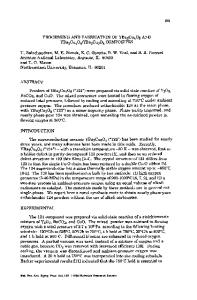Preparation of YBa 2 Cu 3 O 6+x by a formic acid method
- PDF / 358,601 Bytes
- 4 Pages / 593.28 x 841.68 pts Page_size
- 90 Downloads / 352 Views
Synthesis of YBa2Cu3O6+;c from formic acid solutions of stoichiometric amounts of the initial materials has been investigated in the temperature range 750-950 °C. The reaction is strongly influenced by the concentration of formic acid. Dilute solutions favor synthesis of purer samples under moderate conditions of temperature and sintering time. At lower temperature the same effect can be achieved if sintering time is longer, while at higher temperature, multiple grinding and heating at very short intervals are necessary to avoid formation of Y2BaCuO5. The observed effect of HCOOH concentration is explained by the different mechanisms involved in the decomposition of the formates obtained.
I. INTRODUCTION The remarkable properties of the superconductor and semiconductor YBa2Cu3O6+* have led to rapid and intensified research on these and like compounds. Recently, we have studied the catalytic effects of these materials in ammoxidation and combustion reactions.1'2 Traditionally, YBa2Cu3O6+;t is prepared by the ceramic method, which involves sintering of salts or oxides at high temperatures.3'4 This method, though effective, is time and energy consuming, and leads to samples with low specific surface areas which usually are below 0.10.2 m^g.1 In most preparations BaCO3 is used, but its decomposition tends to be incomplete, and this may be the main origin of the carbonates observed in most XPS studies.5"7 On the other hand, the use of high temperature to ensure decomposition of BaCO3 leads to incongruent melting with formation of many phases.8 The use of BaO would have been interesting, but it reacts easily with CO2 to form BaCO3 so that the use of long stored stock influences the amount of reagent required for the reaction. Methods such as coprecipitation of metal carbonates,9 oxalates,10 and citrates11 have been explored, but satisfactory results are obtained only after a long period of heating and secondary treatment of samples. Sol-gel methods12"14 are interesting, but they involve rigorous procedures. For catalytic and other surface studies, it is desirable to have samples with higher specific surface areas than those obtained by the traditional methods. To achieve this objective, a simpler method that does not involve prolonged sintering at high temperature is needed. We report here a method involving formic acid. II. PROCEDURE
Materials: BaCO 3 , Ba(OH) 2 -8H 2 O, CuO, and HCOOH 98-100% are all Merck p.A. products. Y2O3 of 99.99% purity was from Ventron. 1388
http://journals.cambridge.org
J. Mater. Res., Vol. 5, No. 7 Jul 1990
Downloaded: 14 Mar 2015
Preparation: Dilute solutions of HCOOH were prepared in the volume ratios 3:1, 1:1, 1:10, and 1:40 of HCOOH:H2O, to obtain a total volume of 80, 40, 120, and 820 ml, respectively. In each solution, 2.7942 grams of Ba(OH)2 • 8H2O or 1.7480 grams of BaCO3 were dissolved, and then 1.0569 grams of CuO and 0.5002 grams of Y2O3 dissolved in 10 ml of warm 65% HNO3 were added. The resulting solution was evaporated until a jelly-like solution was obtained, except for so
Data Loading...











